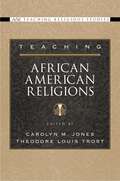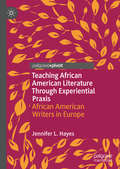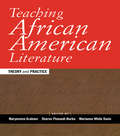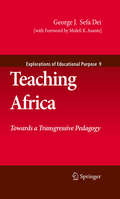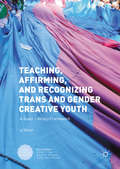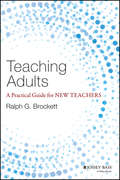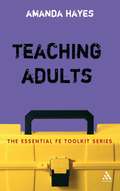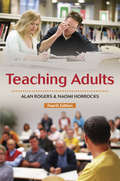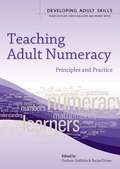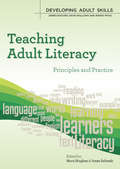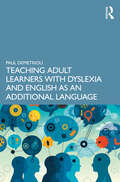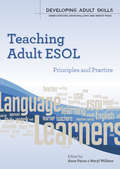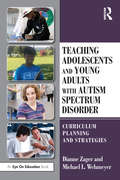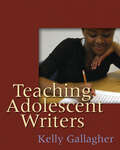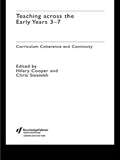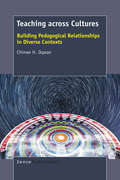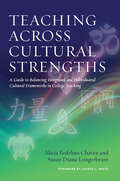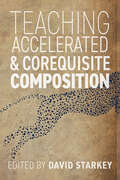- Table View
- List View
Teaching African American Religions (AAR Teaching Religious Studies)
by Carolyn M. Jones Theodore Louis TrostThe variety and complexity of its traditions make African American religion one of the most difficult topics in religious studies to teach to undergraduates. The sheer scope of the material to be covered is daunting to instructors, many of whom are not experts in African American religious traditions, but are called upon to include material on African American religion in courses on American Religious History or the History of Christianity. Also, the unfamiliarity of the subject matter to the vast majority of students makes it difficult to achieve any depth in the brief time allotted in the survey courses where it is usually first encountered. The essays in this volume will supply functional, innovative ways to teach African American religious traditions in a variety of settings.
Teaching African American Literature Through Experiential Praxis: African American Writers in Europe
by Jennifer L. HayesThis book focuses on teaching African American literature through experiential praxis. Specifically, the book presents several canonical African American literature authors in a study abroad context. The book chapters consider the historical implications of travel within the African American literature tradition including slave narratives, migration narratives, and expatriate narratives. The book foregrounds this tradition and includes activities, rhetorical prompts, and thematic discussion that support instruction.
Teaching African American Literature: Theory and Practice (Transforming Teaching Ser.)
by Maryemma Graham Sharon Pineault-Burke Marianna White DavisThis book is written by teachers interested in bringing African American literature into the classroom. Documented here is the learning process that these educators experienced themselves as they read and discussed the stories & pedagogical.
Teaching African American Literature: Theory and Practice
by Maryemma Graham Sharon Pineault-Burke Marianna White DavisThis book is written by teachers interested in bringing African American literature into the classroom. Documented here is the learning process that these educators experienced themselves as they read and discussed the stories & pedagogical.
Teaching Africa: Towards a Transgressive Pedagogy (Explorations of Educational Purpose #9)
by George J. Sefa DeiOne is always struck by the brilliant work of George Sefa Dei but nothing so far has demonstrated his pedagogical leadership as much as the current project. With a sense of purpose so pure and so thoroughly intellectual, Dei shows why he must be credited with continuing the motivation and action for justice in education. He has produced in this powerful volume, Teaching Africa, the same type of close reasoning that has given him credibility in the anti-racist struggle in education. Sustaining the case for the democratization of education and the revising of the pedagogical method to include Indigenous knowledge are the twin pillars of his style. A key component of this new science of pedagogy is the crusade against any form of hegemonic education where one group of people assumes that they are the masters of everyone else. Whether this happens in South Africa, Canada, United States, India, Iraq, Brazil, or China, Dei’s insights suggest that this hegemony of education in pluralistic and multi-ethnic societies is a false construction. We live pre-eminently in a world of co-cultures, not cultures and sub-cultures, and once we understand this difference, we will have a better approach to education and equity in the human condition.
Teaching, Affirming, and Recognizing Trans and Gender Creative Youth: A Queer Literacy Framework (Queer Studies and Education)
by Sj MillerWinner of the 2018 Outstanding Book by the Michigan Council Teachers of EnglishChoice magazine as an Outstanding Academic Title for 2018Winner of the 2017 AERA Division K (Teaching and Teacher Education) Exemplary Research AwardThis book draws upon a queer literacy framework to map out examples for teaching literacy across pre-K-12 schooling. To date, there are no comprehensive Pre-K-12 texts for literacy teacher educators and theorists to use to show successful models of how practicing classroom teachers affirm differential (a)gender bodied realities across curriculum and schooling practices. This book aims to highlight how these enactments can be made readily conscious to teachers as a reminder that gender normativity has established violent and unstable social and educational climates for the millennial generation of lesbian, gay, bisexual, transgender, intersex, (a)gender/(a)sexual, gender creative, and questioning youth.
Teaching Adults: A Practical Guide for New Teachers
by Ralph G. BrockettA highly practical guide for new instructors teaching in any setting Regardless of the context, teaching is a tall task—and for those teaching adults, unique challenges await. Teaching Adults: A Practical Guide for New Teachers is chock-full of ideas that can be read quickly and implemented immediately in formal and informal settings, in classrooms and workplaces; in short, wherever adults are learning. Written with straightforward language that eschews jargon, yet grounded in theory, research, and practice in adult education, the book will benefit readers who have not previously been exposed to these ideas as well as more experienced teachers who seek new ways to reach adult learners. The book will serve as a resource to revisit from time to time as readers face new challenges and questions in teaching adults. Readers will delve into to a variety of topics, including: A general teaching framework, including the author's four keys to effective teaching An in-depth exploration of the primary components of effective teaching An examination of the unique challenges involved with teaching adults, including how to best create a positive learning environment, overcoming resistance to learning, motivation techniques, and dealing with difficult or disruptive learners The book elucidates the techniques required to connect with adult learners and provide instruction that is specifically tailored to the unique learning needs of these students.
Teaching Adults: A Practical Guide for New Teachers
by Ralph G. BrockettA highly practical guide for new instructors teaching in any setting Regardless of the context, teaching is a tall task—and for those teaching adults, unique challenges await. Teaching Adults: A Practical Guide for New Teachers is chock-full of ideas that can be read quickly and implemented immediately in formal and informal settings, in classrooms and workplaces; in short, wherever adults are learning. Written with straightforward language that eschews jargon, yet grounded in theory, research, and practice in adult education, the book will benefit readers who have not previously been exposed to these ideas as well as more experienced teachers who seek new ways to reach adult learners. The book will serve as a resource to revisit from time to time as readers face new challenges and questions in teaching adults. Readers will delve into to a variety of topics, including: A general teaching framework, including the author's four keys to effective teaching An in-depth exploration of the primary components of effective teaching An examination of the unique challenges involved with teaching adults, including how to best create a positive learning environment, overcoming resistance to learning, motivation techniques, and dealing with difficult or disruptive learners The book elucidates the techniques required to connect with adult learners and provide instruction that is specifically tailored to the unique learning needs of these students.
Teaching Adults (Essential FE Toolkit)
by Amanda HayesThis is a survival guide to teaching adults in FE. Amanda Hayes places students at the heart of teaching and learning and provides readers with practical strategies to help them create a stimulating and effective learning environment in college, workplace and community venues.  A wide range of issues are covered including: catering for different learning styles, managing learner's expectations, promoting diversity and social inclusion, learning in the workplace and dealing with punctuality and retention. A variety of approaches are presented from which the reader can develop effective teaching and support strategies for their own situation and ensure that their adult students successfully gain academic and vocational skills, as well as self confidence.Â
Teaching Adults (UK Higher Education OUP Humanities & Social Sciences Education OUP)
by Alan Rogers Naomi HorrocksThe current edition of Teaching Adults, 3e provides an overview of teaching adults in a range of different contexts. In doing so, the author aims to cover the key principles that he believes teachers of adults will encounter and may find useful to know. The new edition will retain the strengths of the current edition:•Engaging writing style•Clear links between theory and practice•Accessible nature•Comprehensive overview of teachingThe new edition will also feature the following:•Up to date further reading and references •The authors plan to strengthen the CPD coverage in the new editionThe new edition aims to retain the overall theme of what is distinctive about adult education.
Teaching Adult Numeracy: Principles And Practice (UK Higher Education OUP Humanities & Social Sciences Education OUP)
by Graham Griffiths Rachel StoneThis book offers friendly guidance on how to work with adult learners to develop their numeracy and mathematics skills. It brings together current research and practice on teaching adult numeracy into one handy volume and covers the major issues faced by teachers of adult numeracy such as current policy perspectives and implications for teaching practice. There are reflective tasks throughout, which encourage you to develop and apply your theoretical knowledge to your own experiences.Key features include: Reviews of existing policy and research and implications for practiceReflective tasks with commentary, encouraging you to develop and apply your knowledgeCase studies of real student experiencesPractical activities and ideas to support the planning, teaching and assessment of adult numeracyDrawing on the substantial experience of the contributors, who have a wealth of experience as practitioners and researchers in the field, this book is an essential resource for trainee and practising teachers of adult numeracy and mathematics. It is also an ideal textbook to support teacher training courses leading to a subject specific qualification in teaching numeracy to adults. Contributors: Jackie Ashton, John Barton, Carolyn Brooks, Martyn Edwards, Janette Gibney, David Holloway, David Kaye, Beth Kelly, Barbara Newmarch, Helen Oughton, David Prinn, Diana Spurr, Rebecca Woolley"This is a quite unique book about teaching adult numeracy, which will be invaluable to the many practitioners in this field. The chapters, contributed by a group of experienced and successful lecturers and practitioners, include all aspects of this field, from methods of teaching specific mathematical topics to more general explorations of dyscalculia and emotional factors in adult learners. Each chapter includes research findings and thoughtful presentation of ideas with practical ideas for teaching, and tasks for the reader. This is a market which has not been served well in the past, so it is good to see the gap filled at last."Margaret Brown, Emeritus Professor of Mathematics Education, King's College London, UK"The editors of this book set out to produce a text that would support teacher-education programmes for adult numeracy, and their book does that and more. The content covers different types of learners, different settings, different understandings of what numeracy actually is; and ranges from commentary on research through case studies to "how to" hints and tips for teaching. Chapters 7 (on provoking mathematical thinking) and 8 (attitudes, beliefs and teaching) should be a required read for any adult numeracy teacher. The book would be at home on any numeracy teacher's desk, and would make an excellent set text for numeracy teacher training courses."Carol Randall, course co-ordinator for numeracy in the department of Lifelong Learning Teacher Education, University of Greenwich, UK"This book is a welcome addition to the growing literature on adult numeracy. It should be essential reading for trainee and practising adult numeracy educators. It brings together relevant research and professional wisdom on a wide variety of aspects of adult numeracy teaching and learning in an accessible way, with well-focussed tasks for readers to extend their knowledge and understanding. While the book is born out of UK concerns and issues, it is also relevant to international readers. Highly recommended."Professor Diana Coben PhD, Director, National Centre of Literacy & Numeracy for Adults, University of Waikato, New Zealand, and Hon. Trustee, Adults Learning Mathematics - A Research Forum (ALM -- www.alm-online.net/)
Teaching Adult Literacy: A Teacher Education Handbook (UK Higher Education OUP Humanities & Social Sciences Education OUP)
by Nora Hughes Irene SchwabAre you teaching or training to teach literacy to adult learners?Do you want to update and deepen your practice?Yes! Then this is the essential book for you!In this book, the authors offer friendly guidance on how to work with adult learners to develop their literacy skills and practices. They challenge the negative view of adult literacy learners as social 'problems', often described in terms of their deficits. They promote an alternative view of people who have rich resources and skills in many areas of their lives which they can bring to the learning process.The contributing authors have a wealth of experience as practitioners and researchers in the field. They pull together a wide range of current theory and research on adult literacy, offering new perspectives on theory and applications to everyday practice. Key features include:Case studies of real student experiences Samples of learners’ writing with commentary and analysis Application of linguistic theory to literacy teaching Practical suggestions for teaching, planning and assessment Guidance on supporting learners with dyslexia and global learning difficulties Reflective tasks, encouraging readers to develop and apply their knowledge This book is an invaluable resource for trainee teachers studying on literacy specialist courses leading to teaching qualifications, as well as for experienced practitioners wishing to update and deepen their practice.
Teaching Adult Learners with Dyslexia and English as an Additional Language: Practical Tips to Support Best Practice
by Paul DemetriouPacked full of practical tips to use in the classroom, case studies to provide theoretical grounding and ideas to improve inclusion, Teaching Adult Learners with Dyslexia and English as an Additional Language covers all the key areas necessary to ensure inclusive and effective teaching practice in higher and further education settings. This book provides a coherent framework for those looking to develop their knowledge and skills in this challenging area and explores key areas such as: teaching and learning strategies, differentiation, assessment, feedback and supporting students using technology. It provides a unique insight into how to develop a thorough understanding of the needs of learners and the principles and practices of how to meet those needs within a classroom setting. This is an essential introductory book for anyone working or training to work in either Further or Higher Education and who wishes to develop knowledge and skills in the challenging area of supporting and teaching adult EAL learners with learning differences.
Teaching Adult Learners with Dyslexia and English as an Additional Language: Practical Tips to Support Best Practice
by Paul DemetriouPacked full of practical tips to use in the classroom, case studies to provide theoretical grounding and ideas to improve inclusion, Teaching Adult Learners with Dyslexia and English as an Additional Language covers all the key areas necessary to ensure inclusive and effective teaching practice in higher and further education settings. This book provides a coherent framework for those looking to develop their knowledge and skills in this challenging area and explores key areas such as: teaching and learning strategies, differentiation, assessment, feedback and supporting students using technology. It provides a unique insight into how to develop a thorough understanding of the needs of learners and the principles and practices of how to meet those needs within a classroom setting. This is an essential introductory book for anyone working or training to work in either Further or Higher Education and who wishes to develop knowledge and skills in the challenging area of supporting and teaching adult EAL learners with learning differences.
Teaching Adult ESOL: A Teacher Education Handbook (UK Higher Education OUP Humanities & Social Sciences Education OUP)
by Anne Paton Meryl WilkinsAre you teaching or training to teach English to adult speakers of other languages?Yes! Then this is the essential book for you!This is one of the few books to effectively blend together research, theory and practical pedagogy and link this directly with the context of teaching English to adults. There are reflective tasks throughout, which encourage you to develop and apply your theoretical knowledge to your own experiences.The editors and contributing authors - all experienced practitioners and researchers - share their experience of meeting the diverse needs of learners in the ESOL setting. Learners come from a wide range of cultural, educational and linguistic backgrounds and choose to learn English for a variety of reasons. These factors have important implications for the way the teaching is undertaken. The authors draw on their wealth of experience with adult learners to offer practical strategies for the classroom. Key topics include: Planning, learning and assessment Accuracy and fluency Learning contexts Language analysis, language use and language acquisition This is essential reading for students on adult ESOL subject specialist certificate courses, or integrated Cert Ed/PGCE ESOL courses. It is also of interest to people teaching English outside the UK.Contributors: Vivien Barr, Sue Colquhoun, Jo-Ann Delaney, Clare Fletcher, Marina Spiegel, Helen Sunderland, John Sutter, Efisia Tranza, Mary Weir
Teaching Adolescents and Young Adults with Autism Spectrum Disorder: Curriculum Planning and Strategies
by Dianne Zager Michael L. WehmeyerTeaching Adolescents and Young Adults with Autism Spectrum Disorder supports teachers in preparing secondary students with autism spectrum disorder (ASD) to succeed in school, work and beyond. Focused on enabling students to successfully pursue further education and meaningful career paths, chapters incorporate person-centered, student-directed planning into instructional programming throughout the text. Featuring helpful vignettes to demonstrate concepts in action, curriculum areas address community living skills, academics, social communication and interaction, and career preparation. Grounded in current research and Universal Design for Learning practices, this guide is an essential resource for educators, therapists, and anyone seeking to create fluid, adaptable programs for students with autism spectrum disorders.
Teaching Adolescents and Young Adults with Autism Spectrum Disorder: Curriculum Planning and Strategies
by Dianne Zager Michael L. WehmeyerTeaching Adolescents and Young Adults with Autism Spectrum Disorder supports teachers in preparing secondary students with autism spectrum disorder (ASD) to succeed in school, work and beyond. Focused on enabling students to successfully pursue further education and meaningful career paths, chapters incorporate person-centered, student-directed planning into instructional programming throughout the text. Featuring helpful vignettes to demonstrate concepts in action, curriculum areas address community living skills, academics, social communication and interaction, and career preparation. Grounded in current research and Universal Design for Learning practices, this guide is an essential resource for educators, therapists, and anyone seeking to create fluid, adaptable programs for students with autism spectrum disorders.
Teaching Adolescent Writers
by Kelly GallagherIn an increasingly demanding world of literacy, it has become critical that students know how to write effectively. From the requirements of standardized tests to those of the wired workplace, the ability to write well, once a luxury, has become a necessity. Many students are leaving school without the necessary writing practice and skills needed to compete in a complex and fast-moving Information Age. Unless we teach them how to run with it, they are in danger of being run over by a stampede—a literacy stampede. InTeaching Adolescent Writers , Kelly Gallagher shows how students can be taught to write effectively. Gallagher shares a number of classroom-tested strategies that enable teachers to: Understand the importance of teaching writing and how to motivate young writers Show how modeling from both the teacher and real-world texts builds young writers Provide choice of what to write, which helps elevate adolescent writing, and how to fit it into a rigorous curriculum Help students recognize the importance of purpose and audience Assess essays in ways that drive better writing performance. Infused with humor and illuminating anecdotes, Gallagher draws on his classroom experiences and work as co-director of a regional writing project to offer teachers both practical ways to incorporate writing instruction into their day and compelling reasons to do so.
Teaching Adolescent Writers
by Kelly GallagherIn an increasingly demanding world of literacy, it has become critical that students know how to write effectively. From the requirements of standardized tests to those of the wired workplace, the ability to write well, once a luxury, has become a necessity. Many students are leaving school without the necessary writing practice and skills needed to compete in a complex and fast-moving Information Age. Unless we teach them how to run with it, they are in danger of being run over by a stampede—a literacy stampede. InTeaching Adolescent Writers , Kelly Gallagher shows how students can be taught to write effectively. Gallagher shares a number of classroom-tested strategies that enable teachers to: Understand the importance of teaching writing and how to motivate young writers Show how modeling from both the teacher and real-world texts builds young writers Provide choice of what to write, which helps elevate adolescent writing, and how to fit it into a rigorous curriculum Help students recognize the importance of purpose and audience Assess essays in ways that drive better writing performance. Infused with humor and illuminating anecdotes, Gallagher draws on his classroom experiences and work as co-director of a regional writing project to offer teachers both practical ways to incorporate writing instruction into their day and compelling reasons to do so.
Teaching Across the Early Years 3-7: Curriculum Coherence and Continuity
by Hilary Cooper Chris SixsmithThis practical and accessible book explores ways of developing continuity and coherence in children's learning from three to seven years old. It is based around three case studies in which tutors on Initial Teacher Training courses worked with early years practitioners in three different pre-school settings, each linked to a primary school. The book describes how they successfully managed to plan and teach integrated themes across the age-range in the context of the requirements of the Foundation Stage and the National Curriculum.Each case study has a different focus:* science, design and technology*' the arts' - including an ICT strand* 'the humanities' - including a physical education strandEnglish and mathematics dimensions run through each theme.The book is alive with discussion of children's art, language, drama and music, captured as field notes, writing, drawing, and as video tape. Each chapter concludes with suggestions of ways in which readers can develop the ideas in their own contexts.This book will be invaluable reading for students on Early Years courses, Early Years practitioners, and tutors and mentors in early childhood education.
Teaching Across the Early Years 3-7: Curriculum Coherence and Continuity
by Hilary Cooper Chris SixsmithThis practical and accessible book explores ways of developing continuity and coherence in children's learning from three to seven years old. It is based around three case studies in which tutors on Initial Teacher Training courses worked with early years practitioners in three different pre-school settings, each linked to a primary school. The book describes how they successfully managed to plan and teach integrated themes across the age-range in the context of the requirements of the Foundation Stage and the National Curriculum.Each case study has a different focus:* science, design and technology*' the arts' - including an ICT strand* 'the humanities' - including a physical education strandEnglish and mathematics dimensions run through each theme.The book is alive with discussion of children's art, language, drama and music, captured as field notes, writing, drawing, and as video tape. Each chapter concludes with suggestions of ways in which readers can develop the ideas in their own contexts.This book will be invaluable reading for students on Early Years courses, Early Years practitioners, and tutors and mentors in early childhood education.
Teaching across Cultures: Building Pedagogical Relationships in Diverse Contexts
by Chinwe H. IkpezeTeaching across Cultures: Building Pedagogical Relationships in Diverse Contexts captures the tensions, complexities as well as the transformational potentials of teaching across multiple cultural contexts. The book evolved from cumulative self-studies that examined one teacher educator’s teaching practice, the cultural impact on this practice, and how she facilitated transformative teaching and learning. While every act of teaching occurs across cultures such as institutional culture, invisible cultures, classroom cultures, among others, educators who teach as cultural outsiders have to navigate the tensions, complexities and contradictory realities of cross-cultural teaching. The tensions can be reduced or managed through responsive pedagogy, relationship building and teaching in the third space. These transformational approaches not only help to identify and close the perpetual gaps in teaching and learning but also position effective teaching within a pedagogical common ground that values student voices, facilitates pedagogical flexibility and uses diversity as a teaching tool. In a world of ubiquitous and interactive learning environments, both the physical and virtual spaces play a vital role in teaching and teacher-student relationships. The book points to the necessity of teacher educators’ learning through diverse professional networks but more importantly through self-study. It is only through this introspective examination of one’s teaching and students’ learning as well as taking an ontological attitude to teaching that educators can achieve success in diverse contexts.
Teaching Across Cultural Strengths: A Guide to Balancing Integrated and Individuated Cultural Frameworks in College Teaching
by Alicia Fedelina Chávez Susan Diana LongerbeamCo-published with Promoting learning among college students is an elusive challenge, and all the more so when faculty and students come from differing cultures. This comprehensive guide addresses the continuing gaps in our knowledge about the role of culture in learning; and offers an empirically-based framework and model, together with practical strategies, to assist faculty in transforming college teaching for all their students through an understanding of and teaching to their strengths.Recognizing that each student learns in culturally influenced ways, and that each instructor’s teaching is equally influenced by her or his background and experiences, the authors offer an approach by which teachers can progressively learn about culture while they transform their teaching through reflection and the application of new practices that enrich student learning.The key premise of the book is that deepening student learning and increasing retention and graduation rates requires teaching from a strengths based perspective that recognizes the cultural assets that students bring to higher education, and to their own learning. Derived through research and practice, the authors present their Model of Cultural Frameworks in College Teaching and Learning that highlights eight continua towards achieving the transformation of teaching, and developing more culturally balanced and inclusive practices, over time. They present techniques – illustrated by numerous examples and narratives – for building on cultural strengths in teaching; offer tips and strategies for teaching through cultural dilemmas; and provide culturally reflective exercises. This guide is intended for all faculty, faculty developers or administrators in higher education concerned with equitable outcomes in higher education and with ensuring that all student cultural groups learn and graduate at the same rates.
Teaching Across Cultural Strengths: A Guide to Balancing Integrated and Individuated Cultural Frameworks in College Teaching
by Alicia Fedelina Chávez Susan Diana LongerbeamCo-published with Promoting learning among college students is an elusive challenge, and all the more so when faculty and students come from differing cultures. This comprehensive guide addresses the continuing gaps in our knowledge about the role of culture in learning; and offers an empirically-based framework and model, together with practical strategies, to assist faculty in transforming college teaching for all their students through an understanding of and teaching to their strengths.Recognizing that each student learns in culturally influenced ways, and that each instructor’s teaching is equally influenced by her or his background and experiences, the authors offer an approach by which teachers can progressively learn about culture while they transform their teaching through reflection and the application of new practices that enrich student learning.The key premise of the book is that deepening student learning and increasing retention and graduation rates requires teaching from a strengths based perspective that recognizes the cultural assets that students bring to higher education, and to their own learning. Derived through research and practice, the authors present their Model of Cultural Frameworks in College Teaching and Learning that highlights eight continua towards achieving the transformation of teaching, and developing more culturally balanced and inclusive practices, over time. They present techniques – illustrated by numerous examples and narratives – for building on cultural strengths in teaching; offer tips and strategies for teaching through cultural dilemmas; and provide culturally reflective exercises. This guide is intended for all faculty, faculty developers or administrators in higher education concerned with equitable outcomes in higher education and with ensuring that all student cultural groups learn and graduate at the same rates.
Teaching Accelerated and Corequisite Composition
by David StarkeyTeaching Accelerated and Corequisite Composition is the first book to compile on-the-ground advice and teaching strategies specifically curated for accelerated and corequisite writing courses. Trailblazers in the field from colleges across the United States—who developed a foundation for corequisites by facilitating equity and accessibility for marginalized students—speak to a range of topics and demographics, offering support for instructors and practical advice for improving student success. The book primarily explores accelerated composition through the lens of two-year colleges to answer a central question in the field: to what extent do educators need to alter two-year college curricular design? The contributors also delve into assessment, a crucial process for instructors and their students transitioning to accelerated learning; the key role that reading plays in the writing process; and noncognitive learning, an area of study that has been associated with accelerated learning since its inception. Together these thirteen chapters provide instructors with a strategic approach to teaching accelerated and corequisite composition. Teaching Accelerated and Corequisite Composition points toward a new way of approaching first-year composition: a method of instruction that fosters the growth and success of writers who were once considered underprepared for college writing and are now achieving unprecedented success.
